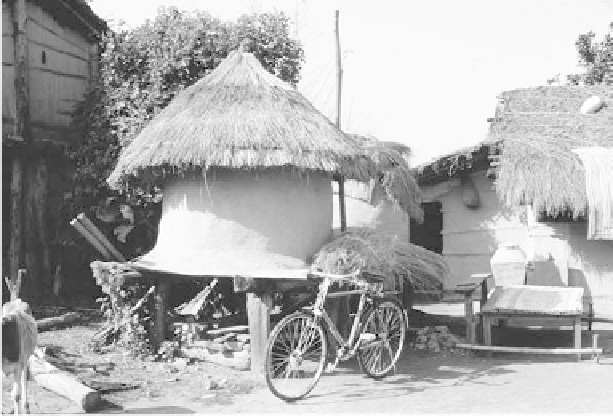Geography Reference
In-Depth Information
The Cotton Fiasco
Cotton is commonly thought of as a fiber crop; we often
wear it. However, cotton is also a food crop. New BT seeds
can be fed to pigs, chickens, and fish. More importantly ,
cotton seed is 22 percent protein compared to only 7 to 10
percent for rice, wheat, and other grains. Kernels, when
roasted and salted, have a nutty flavor. Further, they can
be ground and combined with wheat or corn flour to make
bread. Cottonseed oil can also be used in food processing.
BT cotton was introduced to India in the late twenti-
eth century by the U.S.-based transnational Monsanto. It
was promoted as being immune to the ruinous pest, boll-
worm. Farmers were convinced to buy the new seeds
even though they cost 4 1/2 times the cost of regular
seeds. Within two years, cotton blight destroyed the crop.
Indebted farmers lost their land and homes and could no
longer feed their families. As of 2009, more than 100,000
BT farmers have committed suicide, ironically by drink-
ing the pesticides that were supposed to save their crops.
that running water does not reach the upper floors of
buildings. Complaints regarding water supply and the
stench of waste have caused some governments to place
limits on the use of urban land for crops and livestock.
THE GREEN REVOLUTION AND BT CROPS
Since the 1960s, farmers have been planting
high-yielding
varieties
of rice, wheat, corn, and other crops. These were
developed at research institutions around the world in an
effort to sustain burgeoning populations. High-yielding
rice was developed at the International Rice Research In-
stitute in the Philippines. These stronger, higher-yielding,
pest-resistant seeds, along with appropriate management
techniques, generated the
Green Revolution.
T ougher
seeds enabled the use of hitherto vacant land. From the
mid-1960s to the mid-1980s, land under rice production
increased by 15 percent in Asia but crop yields jumped by
74 percent! Currently , every 2.47 acres (1 hectare) of
paddy fields in Asia provides enough rice to feed 27 peo-
ple. However, 50 years from now , according to some pro-
jections, each hectare will have to provide for 43 people.
In an effort to increase the food supply , scientists
have invented what are called
biotech or BT crops
. BT
crops are also referred to as GE (genetically engineered)
crops. BT seeds are bred to resist disease and pests. Now
BT rice, developed in China, is being sown in 50 percent
of the country' s rice paddies. BT rice requires only half
the amount of pesticide as applied to regular rice. T Today, ,
China produces a third of the world' s rice. While BT
crops are promising in terms of increasing food supply ,
they have their downside.
CROP LOSSES
All crops can quickly decimate by floods and droughts.
Also, they are prone to physical damage as well as disease
when exposed to pests such as rats, insects, and worms
residing in the crevices of poorly or loosely woven, or old
and torn grain baskets Figure 5-4. For example, Sri Lanka
loses up to 40 percent of its food due to poor storage facil-
ities. In 2009, Bangladesh lost 18 percent of its rice and
vegetables because of inadequate storage facilities. Insec-
ticides and pesticides cannot combat 175 types of insects
Figure 5-4
This rice storage bin in Nepal is made of straw
plastered with mud. Note that it is raised above
ground to be out of the rain and to deter snakes
and rodents. However , many predators can climb
and bore through the mud. The straw roof also does
not keep out bugs or other creatures that will eat
the grain.
Photo courtesy of B. A. Weightman.


















Search WWH ::

Custom Search